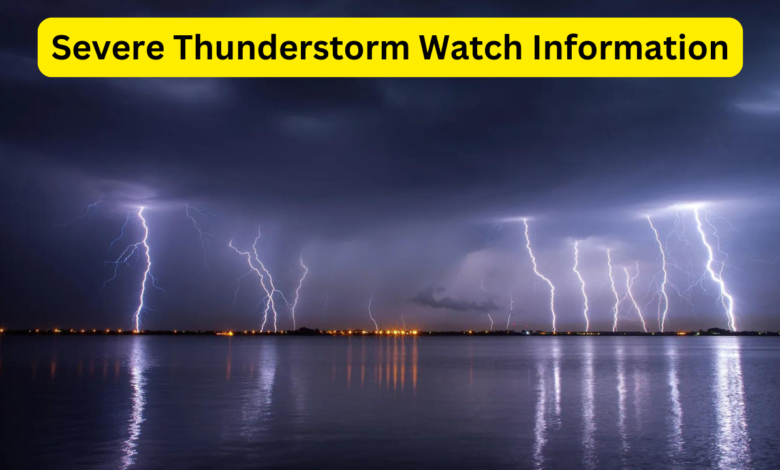Severe Thunderstorm Watch Information

Severe Thunderstorm Watch, Severe thunderstorms are intense weather events capable of causing substantial damage and posing serious risks to life and property. A severe thunderstorm watch is a crucial alert system issued by meteorological authorities to warn the public about the potential for severe weather conditions. This comprehensive guide will provide an in-depth look at severe thunderstorm watches, their implications, and the best practices for preparedness.
What is a Severe Thunderstorm Watch?
A severe thunderstorm watch is issued by the National Weather Service (NWS) when atmospheric conditions are conducive to the development of severe thunderstorms in a specific region. Unlike a severe thunderstorm warning, which signifies that severe weather is imminent or currently occurring, a watch indicates the possibility of such weather. This alert typically covers a broader area and a longer time frame than warnings.
Criteria for Issuing a Severe Thunderstorm Watch
Several factors contribute to the issuance of a severe thunderstorm watch:
- Severe Weather Parameters: The atmosphere must support severe weather development. This includes high moisture levels, atmospheric instability, and favorable wind patterns conducive to storm formation.
- Historical Data: Previous weather patterns and trends are assessed to predict the likelihood of severe thunderstorms.
- Forecast Models: Advanced meteorological models predict storm formation and movement based on current atmospheric conditions.
Understanding Severe Thunderstorm Warnings
A severe thunderstorm warning is more urgent than a watch. It is issued when severe thunderstorms are detected by radar or observed, indicating that immediate action is required to protect life and property. Key indicators of severe thunderstorms include:
- Hail: Hailstones with a diameter of at least one inch.
- Damaging Winds: Winds exceeding 58 miles per hour.
- Tornadoes: While not always present, tornadoes can develop from severe thunderstorms.
Impact of Severe Thunderstorm Watches on Daily Life
Severe thunderstorm watches can significantly disrupt daily activities. Here’s how:
- Outdoor Activities: It’s advisable to postpone outdoor events, sports, and activities to avoid risks associated with severe weather.
- Travel Plans: Review and adjust travel plans based on the watch. Stay updated on weather conditions to prepare for potential travel disruptions.
- Emergency Preparedness: Ensure that you have an emergency plan in place. All family members should be aware of the plan and know the actions to take during severe weather.
How to Prepare for a Severe Thunderstorm Watch
Effective preparation is crucial for minimizing the impact of severe thunderstorms. Here are some essential steps:
- Stay Informed
- Weather Alerts: Regularly check local weather reports and alerts. Utilize weather apps, NOAA Weather Radio, and local news channels for real-time updates.
- Weather Radios: Keep a battery-powered weather radio accessible for updates during power outages.
- Create an Emergency Kit
- Essential Supplies: Stock non-perishable food, water, medications, flashlights, batteries, and a first-aid kit.
- Important Documents: Store crucial documents in a waterproof container to prevent loss.
- Secure Your Home
- Check Property: Inspect and secure outdoor items that could become dangerous projectiles in high winds.
- Reinforce Structures: Ensure that windows, doors, and roofs are robust enough to withstand severe weather conditions.
- Review Safety Procedures
- Sheltering: Designate and prepare a safe area in your home for shelter during severe weather.
- Emergency Contacts: Update and share contact information with family and friends.
During a Severe Thunderstorm Watch
When a severe thunderstorm watch is in effect, take these actions:
- Monitor Conditions
- Weather Updates: Continuously track weather conditions and updates. Be alert to any changes that could lead to a severe thunderstorm warning.
- Lightning Safety: Avoid using electrical appliances and remain indoors during lightning storms.
- Stay Indoors
- Avoid Windows: Keep away from windows and exterior doors to reduce the risk of injury from flying debris.
- Seek Shelter: If a severe thunderstorm warning is issued, move to your designated safe area immediately.
After the Severe Thunderstorm
Once the severe weather has passed, take the following steps:
- Inspect for Damage
- Property Assessment: Evaluate any damage to your property and report it to local authorities if necessary.
- Safety Hazards: Be cautious of hazards such as downed power lines and structural damage.
- Stay Informed
- Recovery Information: Follow updates from local authorities regarding recovery efforts and safety recommendations.
- Community Support: Seek assistance from community resources and support services if needed.
Monitoring Weather Updates Effectively
During a severe thunderstorm watch, it is crucial to stay up-to-date with the latest weather information. Leverage multiple sources to ensure you receive timely updates. In addition to weather apps and NOAA Weather Radio, consider following local meteorologists on social media for real-time alerts and insights. These platforms often provide detailed, location-specific information that can help you make informed decisions about safety measures. By utilizing a combination of sources, you can stay ahead of changing weather conditions and adjust your preparedness plans accordingly.
Community Engagement and Resources
Community preparedness can greatly enhance individual safety during severe weather events. Engage with local community groups and emergency services to stay informed about regional preparedness efforts. Many communities have established networks for disseminating emergency information and providing assistance during severe weather. Participate in community safety programs and consider joining local emergency response teams. These resources not only provide valuable support during a severe thunderstorm watch but also foster a sense of collective responsibility and readiness.
Technology and Innovation in Weather Monitoring
Advancements in technology have significantly improved weather monitoring and forecasting capabilities. Modern weather satellites, radar systems, and data analytics tools enable meteorologists to detect and predict severe weather with greater accuracy. By staying informed about these technological advancements, you can better understand the reliability of weather alerts and warnings. Invest in advanced weather monitoring devices, such as personal weather stations, to receive precise updates tailored to your location. Utilizing these technologies can enhance your ability to respond effectively to severe weather conditions.
Long-Term Preparedness and Resilience
Preparedness for severe thunderstorms extends beyond immediate actions during a watch. Develop a comprehensive long-term preparedness plan that includes regular updates to your emergency kit, ongoing education about severe weather risks, and periodic review of your home’s structural integrity. Implementing resilience strategies, such as reinforcing your home’s exterior and creating a family communication plan, can reduce the impact of severe weather events. By proactively addressing these aspects, you can build long-term resilience and better safeguard your home and family against future severe thunderstorm watches and warnings.
Conclusion
Understanding severe thunderstorm watches and preparing accordingly can greatly enhance safety and mitigate the impacts of severe weather. By staying informed, preparing an emergency kit, and taking appropriate actions during a watch, individuals can better protect themselves and their property.




One Comment